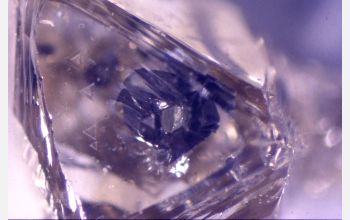Multimedia Gallery
Inclusion-bearing Rough Diamond
A sulfide, inclusion-bearing rough diamond from the Jwaneng Mine in Botswana. This optical photomicrograph shows the natural diamond growth surface. Below the surface and at the center is a brass-colored, hexagonal-shaped grain of iron sulfide surrounded by an irregular black rim. The rim is caused by internal fracture of the diamond on its ascent to the Earth's surface via explosive volcanism. Sulfide grains such as these are removed for sulfur isotopic analysis.
More about this Image
National Science Foundation (NSF)-supported geologists James Farquhar and Boswell Wing from the University of Maryland have found that tiny inclusions encased in diamonds preserve information about the cycling of material between the Earth's atmosphere, crust and mantle some 3 billion years ago.
The researchers studied ratios of isotopes--atoms that are of the same type, but have a slightly different size--and tracked distinctive "isotopic signatures" that are unique to rocks that were created in the same place. By tagging a rock throughout its life cycle, researchers can use isotopic signatures to draw conclusions about previously unknown parts of Earth's early history, such as how the atmosphere evolved and the origin of early life-forms.
Farquhar and Wing, along with colleagues from other institutions, have shown that sulfide inclusions in diamonds from Botswana contain a characteristic ratio of the three isotopes of sulfur. This finding indicates that these sulfur atoms completed an entire geochemical cycle on Earth--from the air to the rocks to everywhere in between. This first documentation of the complete recycling of ancient sulfur adds to the knowledge of the dynamic processes that shaped our planet's evolution.
To learn more about this research, see the NSF News Tip Sulfur Signature in Diamonds Reveals New Facts about Early Earth. (Year of image: 2003)
Credit: Jeff Harris, University of Glasgow, U.K.
See other images like this on your iPhone or iPad download NSF Science Zone on the Apple App Store.
Images and other media in the National Science Foundation Multimedia Gallery are available for use in print and electronic material by NSF employees, members of the media, university staff, teachers and the general public. All media in the gallery are intended for personal, educational and nonprofit/non-commercial use only.
Images credited to the National Science Foundation, a federal agency, are in the public domain. The images were created by employees of the United States Government as part of their official duties or prepared by contractors as "works for hire" for NSF. You may freely use NSF-credited images and, at your discretion, credit NSF with a "Courtesy: National Science Foundation" notation.
Additional information about general usage can be found in Conditions.
Also Available:
Download the high-resolution TIFF version of the image. (3.2 MB)
Use your mouse to right-click (Mac users may need to Ctrl-click) the link above and choose the option that will save the file or target to your computer.

